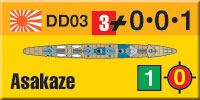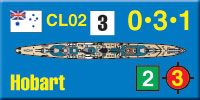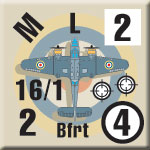| Eastern Fleet:
The Playbook Edition
By Mike Bennighof, Ph.D.
February 2022
 Second World War at Sea: Eastern Fleet’s Second Edition is the model for what we want to do with the Second World War at Sea series. The game’s built around the April 1942 Japanese incursion into the Indian Ocean with the First Air Fleet of five heavy carriers, plus an additional light carrier operating semi-independently. The Royal Navy opposed them with their Eastern Fleet, a force built around two aircraft carriers, one capable modernized battleship, and a collection of cruisers, destroyers and floating scrap heaps. Second World War at Sea: Eastern Fleet’s Second Edition is the model for what we want to do with the Second World War at Sea series. The game’s built around the April 1942 Japanese incursion into the Indian Ocean with the First Air Fleet of five heavy carriers, plus an additional light carrier operating semi-independently. The Royal Navy opposed them with their Eastern Fleet, a force built around two aircraft carriers, one capable modernized battleship, and a collection of cruisers, destroyers and floating scrap heaps.
We initially issued the Second Edition in a box, with a new map, new scenario book, new full-color play aids, new series rules and additional playing pieces. Only the original sheet of playing pieces survived from the First Edition.
Eastern Fleet became the embodiment of an idea I had held for many years, but hadn’t quite figured out how to execute: to use a historical wargame as a vehicle to tell the story of the battle, campaign or war it claims to simulate. The scenarios – Eastern Fleet has 30 of them, a dozen operational scenarios and eighteen battle scenarios – become the means to advance the narrative.
 That concept’s built around some confidential data that a much larger role-playing game publisher shared with me a long time ago, based on some intensive customer surveys. “Most games,” their study concluded, “are consumed as literature.” That means, when translated out of jargon, that people don’t have to actually play every scenario of the game to find it enjoyable. Plenty of them will be readers, rather than players, who like following the story in game format. If something along the way strikes them, then they can break the game out and play it. They can play some of the scenarios, all of them, or none of them, and in each case feel they’ve had a satisfying experience. That concept’s built around some confidential data that a much larger role-playing game publisher shared with me a long time ago, based on some intensive customer surveys. “Most games,” their study concluded, “are consumed as literature.” That means, when translated out of jargon, that people don’t have to actually play every scenario of the game to find it enjoyable. Plenty of them will be readers, rather than players, who like following the story in game format. If something along the way strikes them, then they can break the game out and play it. They can play some of the scenarios, all of them, or none of them, and in each case feel they’ve had a satisfying experience.
While I’d like to think that every player will play every scenario, that’s not realistic. Those thirty scenarios would probably take well over 100 hours to play face-to-face. But the alternative – offering a handful, on the grounds that most players will only play a handful – isn’t satisfying to me. I want players to have a wide choice, to follow the story and dive in to participate themselves at the points they find most exciting, including an ample variety of battle scenarios, since those allow the players to get right to the real action (sinking ships and shooting down airplanes). That means that the game has to be crafted as though every scenario will be played many times by every player.
 Eastern Fleet’s main event is the April 1942 Japanese carrier operation, but the game also studies operations in the eastern Indian Ocean in some depth. Following their bitter experience fighting the First Air Fleet, the British strengthened their Eastern Fleet and remained highly cautious in their operations, supporting them with both carriers and battleships. Even after the Japanese lost four of their six fleet carriers at Midway, the British remained alert to the possibility that the remaining two heavy carriers could appear in the Indian Ocean. And with good reason: the Japanese considered further operations there until the American landings on Guadalcanal in August 1942 drew their attention to the South Pacific. Eastern Fleet’s main event is the April 1942 Japanese carrier operation, but the game also studies operations in the eastern Indian Ocean in some depth. Following their bitter experience fighting the First Air Fleet, the British strengthened their Eastern Fleet and remained highly cautious in their operations, supporting them with both carriers and battleships. Even after the Japanese lost four of their six fleet carriers at Midway, the British remained alert to the possibility that the remaining two heavy carriers could appear in the Indian Ocean. And with good reason: the Japanese considered further operations there until the American landings on Guadalcanal in August 1942 drew their attention to the South Pacific.
And so we study proposed operations, like the Japanese invasion of Ceylon (based on proposals made both before and after the Midway disaster). And several British operations that apparently never drew Japanese notice, let alone opposition – but the Eastern Fleet planned to defend the convoys and other moves, just to be sure.
 That required some additional ship pieces, which is why we added more pieces to the Second Edition. We also included more aircraft pieces, so that Eastern Fleet could use the random-draw mechanic for aircraft assignment that’s been standard in Second World War at Sea for a long time. The region didn’t attract a huge air deployment by either side, so we didn’t need that many to make a difference, but the element of randomness has become very important to the way Second World War at Sea games play – you should have an idea of what ships the enemy can send to sea, but much less of a solid indication of his or her air support. That required some additional ship pieces, which is why we added more pieces to the Second Edition. We also included more aircraft pieces, so that Eastern Fleet could use the random-draw mechanic for aircraft assignment that’s been standard in Second World War at Sea for a long time. The region didn’t attract a huge air deployment by either side, so we didn’t need that many to make a difference, but the element of randomness has become very important to the way Second World War at Sea games play – you should have an idea of what ships the enemy can send to sea, but much less of a solid indication of his or her air support.
All told there are 280 pieces in Eastern Fleet: 100 double-sized “long” ship pieces and 180 standard-sized ones. Most of the latter are aircraft, with some small warships, transports and the handful of markers the game uses making up the rest. Since we had the space for it, some of the ships that appear on the First Edition sheet as “small” ships have been upgraded to a “long” piece with a full top-down drawing of the ship. The map’s a full-size (per our current printing standards) 22x28 inches, showing the entire Bay of Bengal plus the waters south of Ceylon down into the Maldives.
 That adds up to a medium-sized game, as Avalanche Press productions go. It was a little light in its box, but not by much. But rising costs, particularly for shipping, demand some sort of control – and among the items we make, nothing’s more expensive or difficult to ship than game boxes. That adds up to a medium-sized game, as Avalanche Press productions go. It was a little light in its box, but not by much. But rising costs, particularly for shipping, demand some sort of control – and among the items we make, nothing’s more expensive or difficult to ship than game boxes.
We’ve added to the story with the Campaign Study, Eastern Fleet: Gulf of Aden, to look at what might have happened had the Japanese decided to overstretch themselves to the west (the Horn of Africa) instead of toward the east (Midway). We’ll also return to the Eastern Fleet map for a Great War at Sea variant (Bay of Bengal), and of course for our alternative-history story arcs, the Second Great War and The Long War.
 Eastern Fleet: Playbook Edition has everything that we included in the boxed Second Edition, with the scenario book getting some additional editing – contrary to the stable genius game designer who proclaimed that “My work needs no editting!”, you should never pass up another round of editing. Eastern Fleet’s scenario book had some text-fill problems that likely went unnoticed by most, but we fixed those, and added some historical background to flesh out the book to a standard length for printing. Everything you need to play is right there in the package, except for dice, and you’ve got plenty of those. Eastern Fleet: Playbook Edition has everything that we included in the boxed Second Edition, with the scenario book getting some additional editing – contrary to the stable genius game designer who proclaimed that “My work needs no editting!”, you should never pass up another round of editing. Eastern Fleet’s scenario book had some text-fill problems that likely went unnoticed by most, but we fixed those, and added some historical background to flesh out the book to a standard length for printing. Everything you need to play is right there in the package, except for dice, and you’ve got plenty of those.
That makes for a fine package, almost entirely Made in the USA for those who care about such things, and most importantly from our perspective one we can more easily keep in stock than a boxed game. Eastern Fleet is one we want to have on our shelves here as long as there is an Avalanche Press.
Click here to order Eastern Fleet Playbook edition!
Sign up for our newsletter right here. Your info will never be sold or transferred; we'll just use it to update you on new games and new offers.
Mike Bennighof is president of Avalanche Press and holds a doctorate in history from Emory University. A Fulbright Scholar and NASA Journalist in Space finalist, he has published a great many books, games and articles on historical subjects; people are saying that some of them are actually good.
He lives in Birmingham, Alabama with his wife, three children, and his Iron Dog, Leopold.
Want to keep Daily Content free of third-party ads? You can send us some love (and cash) through this link right here.
|
